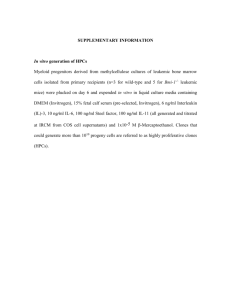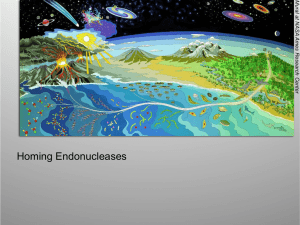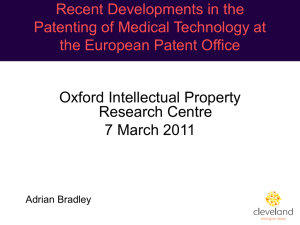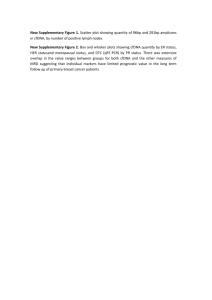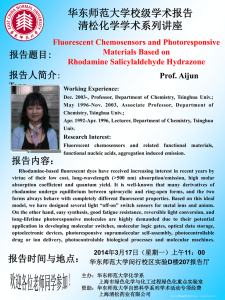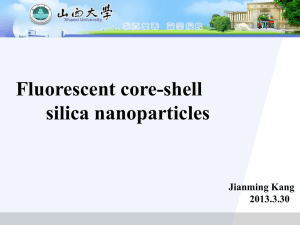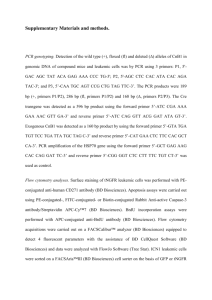Word file (32 KB )
advertisement
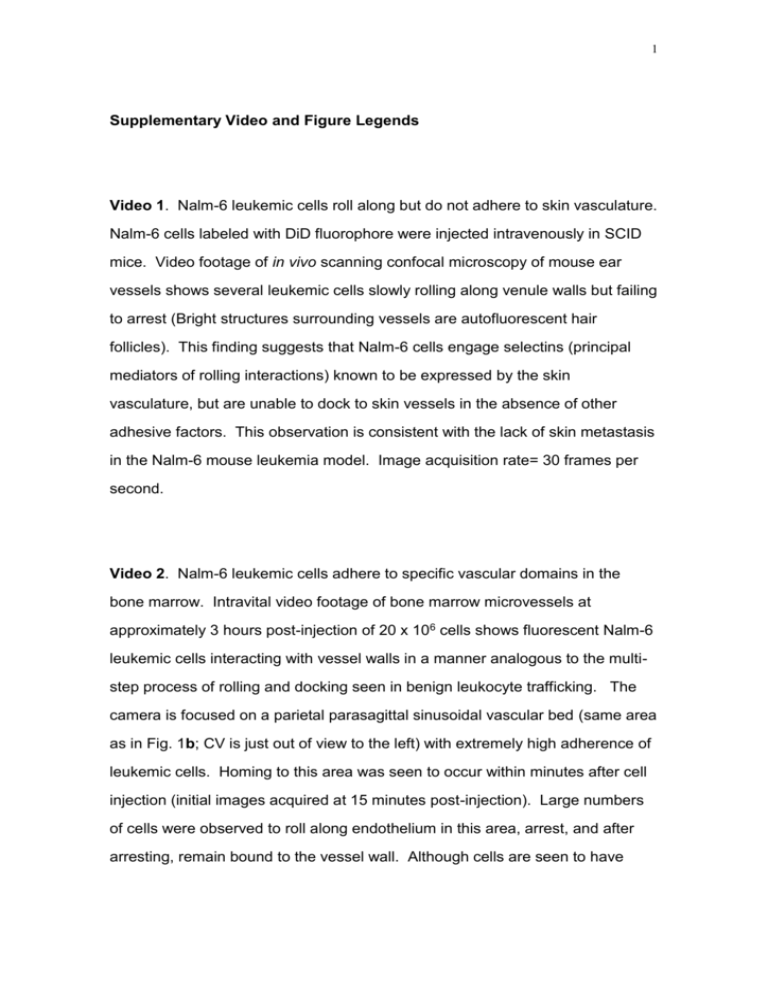
1 Supplementary Video and Figure Legends Video 1. Nalm-6 leukemic cells roll along but do not adhere to skin vasculature. Nalm-6 cells labeled with DiD fluorophore were injected intravenously in SCID mice. Video footage of in vivo scanning confocal microscopy of mouse ear vessels shows several leukemic cells slowly rolling along venule walls but failing to arrest (Bright structures surrounding vessels are autofluorescent hair follicles). This finding suggests that Nalm-6 cells engage selectins (principal mediators of rolling interactions) known to be expressed by the skin vasculature, but are unable to dock to skin vessels in the absence of other adhesive factors. This observation is consistent with the lack of skin metastasis in the Nalm-6 mouse leukemia model. Image acquisition rate= 30 frames per second. Video 2. Nalm-6 leukemic cells adhere to specific vascular domains in the bone marrow. Intravital video footage of bone marrow microvessels at approximately 3 hours post-injection of 20 x 106 cells shows fluorescent Nalm-6 leukemic cells interacting with vessel walls in a manner analogous to the multistep process of rolling and docking seen in benign leukocyte trafficking. The camera is focused on a parietal parasagittal sinusoidal vascular bed (same area as in Fig. 1b; CV is just out of view to the left) with extremely high adherence of leukemic cells. Homing to this area was seen to occur within minutes after cell injection (initial images acquired at 15 minutes post-injection). Large numbers of cells were observed to roll along endothelium in this area, arrest, and after arresting, remain bound to the vessel wall. Although cells are seen to have 2 rolling interactions with venules leading into this region, only occasional cells adhere outside the parasagittal domain. This area was imaged for several hours after injection, during which time leukemic cells continued to home to this vascular bed, with the density of bound cells increasing until only scarce cells remained in circulation. Video 3. Another view of Nalm-6 leukemic homing interactions in a bone marrow parasagittal vascular bed (area 3) adjacent to the CV (visible on the right as the tape progresses). Initial views are of the lateral parietal vasculature, where cells can be seen flowing through but not adhering to vessels. As the camera pans to the right, numerous cells are visible bound to the parasagittal sinusoidal vasculature. Multiple cells are also seen bound to the CV, indicating that homing interactions are not strictly vessel caliber- or flow-dependent. Video 4. Footage of extensive Nalm-6 rolling and binding interactions in a large frontal vein possessing high blood flow-rate. Supplementary Figure 1. MatLyLu (MLL) prostatic carcinoma cells home to the same vascular microdomains as Nalm-6 leukemic cells. This montage of images shows fluorescent DiD-labeled MLL cells bound to parasagittal vasculature in areas 3 and 4 of the BM approximately 30 minutes after injection of 5 x 106 cells. The large central vein is seen in the center of the image, 3 surrounded by parasagittal sinusoidal vasculature. Coronal vessels at the top of the image have only rare cells bound to them. Supplementary Figure 2. Nalm-6 binding and SDF-1 expression occur in restricted regions of BM. a. anti-SDF-1-Cy5 binds antigen in BM vascular microdomains in this image from area 4 (arrows). b. BM vasculature in another region in the same mouse (lateral edge of area 3) is mostly negative for SDF-1 expression. The edge of an SDF-1+ vessel is seen toward the right (arrow). c. anti-SDF-1-Cy5 does not bind SDF-1-negative skin vasculature. Hair follicles generate an intense autofluorescence signal (arrowheads). d. An image of fluorescent Nalm-6 cells extensively bound to microvessels in area 3 of BM (arrow). e. In contrast, another BM region in the same animal (lateral edge of area 3) is devoid of leukemic cells. f. No cells are bound to microvessels in the skin. Arrowheads point to autofluorescent hair follicles and keratinocytes. Supplementary Figure 3. PECAM-1 and SDF-1 co-localize to parasagittal vasculature. a. anti-PECAM-1-AlexaFluor750 in vivo immunostaining is shown in red, highlighting the extent of the BM vasculature. Occasional PECAM-1+ monocytes are also stained. b. anti-SDF-1-Cy5 staining in the same mouse is shown in green. Positive staining is limited principally to the parasagittal vasculature and what appear to be adjacent scattered perivascular cells or extracellular matrix material. c. A merged image demonstrates co-localization of the two signals in the parasagittal region. Scale bars = 100 microns. 4 Supplementary Figure 4. Nalm-6 homing is inhibited after SDF-1desensitization treatment. a. Flow cytometric analysis of CXCR4 expression in SDF-1-desensitized cells confirms receptor downregulation. b. Representative image of control Nalm-6 1h post-injection. c. Similar area in another mouse showing SDF-1-desensitized Nalm-6 homing 1h post-injection. Scale bars = 100 m. Supplementary Figure 5. CXCR4 blockade causes modest mobilization of engrafted Nalm-6 leukemic cells into the peripheral circulation. SCID mice engrafted i.v. with approximately 5 x 106 fluorescent DiD-labeled Nalm-6 were treated with a single dose of the CXCR4 inhibitor AMD3100 (1.5 mg/kg i.v.) four days after leukemic engraftment. Changes in the number of fluorescent cells in peripheral circulation post-treatment were then monitored by in vivo flow cytometry and normalized to the pre-AMD3100 baseline (time 0.0). Data from three separate animals are pooled to reveal a two-fold increase in circulating cells approximately 2 hours post-AMD3100. Error bars indicate the standard error of the mean. Supplementary Figure 6. In vitro studies confirm the relative persistence of fluorescence signal in slowly dividing cells (Nalm-6 cultured in 1% FCS, doubling time approximately 6 days), as detected by flow cytometry. In contrast, rapidly dividing cells (Nalm-6 cultured in 10% FCS, doubling time approximately 3 days) dilute a DiD fluorescent membrane dye to undetectable levels after approximately 5 cell divisions. 5 Supplementary Figure 7. Benign T lymphocytes home to the same SDF-1+ vascular microdomains as Nalm-6 leukemic cells. a. A parasagittal SDF-1+ vascular microdomain is shown in green. b. Purified T cells (pooled memory and naïve, isolated from balb/c spleen and injected i.v. in SCID mice) are shown in red. T cells were not observed to home to SDF-1- regions of BM. In a separate experiment (data not shown), naïve T cells were purified from spleen and similar numbers injected in SCID mice. Only rare naïve T cells were observed to home to BM, suggesting that the majority of T cells that home to BM when pooled lymphocytes are injected represent memory T cells. Supplementary Figure 8. VLA-4/VCAM-1 interactions do not appear critical for initial homing of Nalm-6 pre-B ALL to BM. a. VLA4- and VLA4+ subclones (5 x 106 each) were labelled with DiR and DiD respectively and co-injected in SCID mice. BM homing at 2-3h post-injection was quantified by manually counting bound cells in images from corresponding areas of BM (viewed in alternating channels). As shown in this bar graph, no significant difference in early homing is observed between the two populations. Error bars indicate the standard error of the mean. b. Representative images of VLA4- and VLA4+ cells bound in the same BM region as viewed in the DiR and DiD channels respectively. Scale bars = 100 microns. c. No significant difference is observed in BM homing between VLA4+ Nalm-6 cells treated with anti-VLA4 blocking antibody vs. control. d. Representative images of BM homing from mice injected with equal numbers of control vs. antibody-treated Nalm-6. Scale bars = 100 microns. 6 Supplementary Figure 9. Nalm-6 leukemic cells pre-treated with N-Cadherin blocking antibody show altered homing kinetics compared to control. SCID mice were injected with 5 x 106 DiD-labeled cells incubated with blocking antibody (clone GC-4, Sigma) vs. PBS control; numbers of cells in peripheral circulation over time were then monitored by in vivo flow cytometry. Best-fit curves of the combined data from three separate experiments reveal approximately 15-20% more cells in circulation in the N-Cadherin treatment group after 2 hours (steady-state), suggesting that N-Cadherin blockade has a modest effect on Nalm-6 homing in vivo. Supplementary Figure 10. Differences in signal intensity detection by in vivo immunoimaging appear to result from variations in optical properties of the surrounding tissue. The fluorescent blood-pool agent Evan’s Blue (2%), which binds to albumin in the peripheral circulation, is used to demonstrate BM microvessels in the parasagittal region of the mouse skull. Clear differences in signal intensity are seen as one follows vessels medially to laterally (left to right) (note arrows). Since signal intensity is not dependent on binding of the dye to antigen sites on the vessel wall, nor does it consistently correlate with vessel depth (data not shown), these differences are likely caused by variations in the optical qualities (i.e., refractive indices) of the overlying tissue.
